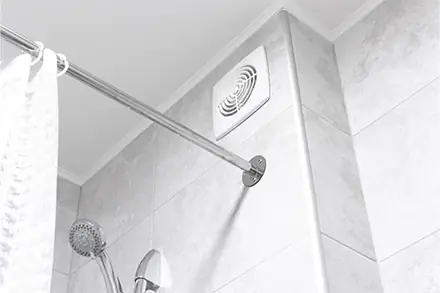
What is an Extractor Fan and why is it necessary?
The purpose of an extractor fan is to extract stale or moist air from a room and helps to circulate fresh air into the room. The fans will draw the old air out of the room into a ducting system which is then expelled outdoors. You can find them mostly in bathrooms and kitchens, due to the unpleasant odours that can build up.
Extractor fans can help massively in reducing moisture levels in a room, which can prevent mould and mildew from developing, making extractor fans a necessity in any healthy indoor environment.
Do you need an Extractor Fan in your Kitchen?
Yes. You should have an extractor fan in your kitchen. Due to the increase odours and temperatures in a kitchen, it can be more susceptible to developing mould. A kitchen extractor fan, alternatively referred to as a cooker extractor fan, is designed to eliminate undesired cooking odours, excess condensation, heat, and fumes from the air within your kitchen. Extractor fans for kitchens, have a range of different extraction rates and controls, such as timer and humidistat function, which will automatically switch on, responding to the humidity in the kitchen. Mould and dampness caused by poor ventilation can have detrimental effects on your health.
Do you need an Extractor Fan in your Bathroom?
Yes, you should have an extractor fan in your bathroom. Due to the use of hot water in baths and showers, bathrooms are especially susceptible to moisture and mould. Things like having a rug in your bathroom can also increase mould as it locks in moisture.
Opening a window in your bathroom (if you have one) can help to reduce the development of mould however we strongly recommend this alongside the use of an extractor fan. The reason for this is people spend a lot of times in bathrooms, so if mould is present, it can seriously affect your health.
Types of Extractor Fans:
There are three main types of extractor fans available for you to purchase, each showing distinct advantages tailored to specific locations and applications. The ideal extractor fan for you will heavily depend on where you plan to install it and the amount of moisture that will need to be extracted.
Inline Extractor Fans.
Inline extractor fans are situated within the ducting pathways, normally concealed in a loft space of ceiling void. Due to their discreet placement, they are favoured in installations involving long ducting or for areas demanding substantial airflow, such as kitchens or spacious bathrooms.
Inline extractor fans can deliver a significantly higher extraction rate, making them particularly well-suited for areas prone to severe condensation or mould issues. In essence, this fan presents an excellent option for those seeking rapid and efficient removal of substantial moisture from their bathroom.
A good choice of Inline Extractor Fan is the National Ventilation UMD100T.
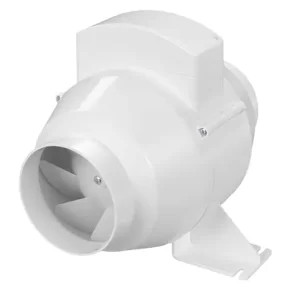
Axial Extractor Fans.
Axial extractor fans are specifically engineered for direct installation through an external wall or in the ceiling, typically on a very short duct pathway. When most individuals envision a bathroom extractor fan, they are likely picturing an axial fan. Nevertheless, it’s important to note that axial extractor fans tend to possess less power compared to inline and centrifugal counterparts.
Consequently, they are not suitable for situations necessitating duct runs exceeding 2 meters in length. Nevertheless, for a standard-sized family bathroom, axial extractor fans are more than adequate for the task at hand. Therefore, if you seek a reliable and straightforward extractor fan installation, opting for an axial model may be the ideal choice for your needs.
A good choice of Axial Extractor Fan is the National Ventilation MONS100TA.
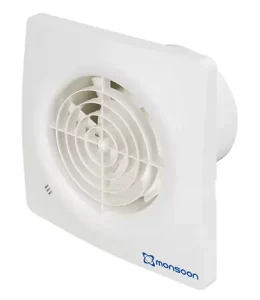
This extractor fan offers several advantages, including an adjustable timer that helps save costs. Part of the Silence range, it operates quietly, with noise levels between 22-25 dB. Additionally, its IP45 ingress rating means it is suitable for installation in both kitchens and bathrooms.
Another great choice of Axial Extractor Fan is the National Ventilation MONS100PCA.
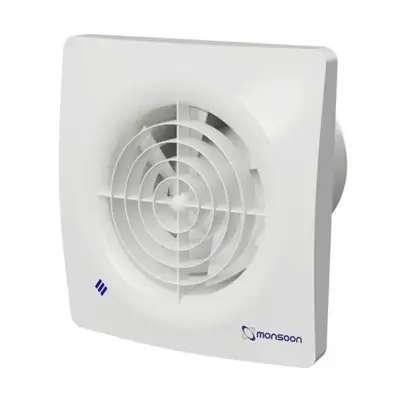
This silent extractor fan is ideal for installation in bathroom Zone 1 thanks to its IP45 ingress rating. It is also suitable for use in kitchens. The fan includes a pull cord, allowing you to control when it operates.
Centrifugal Extractor Fans.
In the realm of bathroom extractor fans, centrifugal fans are far more powerful than your average axial fan. Centrifugal fans function by pulling air into the fan intake and then expelling it at a 90-degree angle. This mechanism generates higher pressure, rendering it an excellent choice for lengthy duct systems. If you happen to have a bathroom without external walls, a centrifugal fan becomes the top choice to ensure effective air circulation.
Moreover, centrifugal fans typically offer a broader range of switching and operational features compared to other fan types. Therefore, if you’re in search of a fan that can endure heavy usage and accomplish the task with precision, a centrifugal fan is your best bet.
A good choice of Centrifugal Extractor Fan is the National Ventilation MONCF100T.
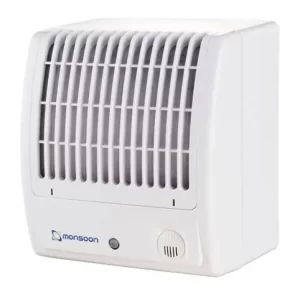
This extractor fan is a great choice due to its adjustable timer which allows you to choose how long the fan runs for (2-30 minutes). Also due to the wide range of fitting options from bathroom/toilets to kitchens and cloakrooms.
Another option when looking for a Centrifugal Extractor Fan is the National Ventilation MONCF100PC.
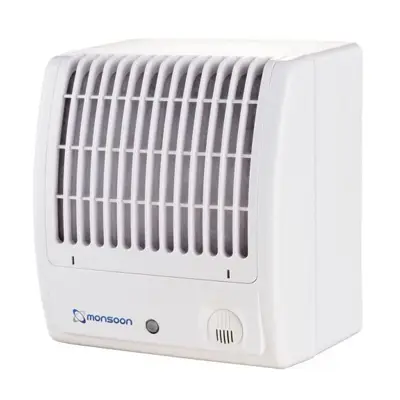
This extractor fan is part of the same range as the MONCF100T, however comes complete with a pull cord to activate the fan. This fan is ideal for bathroom appliations due to its 122m³/hr extraction rate.
How to pick the right Extractor Fan for you:
Operational Style.
When contemplating your choice of bathroom extractor fan, consider how you want it to function. Do you prefer manual activation, or would you like it to automatically switch on when someone enters the room? Some fans come equipped with timers to turn off after a specific time following the light being switched off. Additionally, certain extractor fans incorporate a Passive Infrared Sensor (PIR) that detects moisture levels in the air, activating or deactivating the fan accordingly. Therefore, your operating preferences are a pivotal factor in your purchase decision.
Air Exchange Rate.
The air extraction rate plays a vital role in determining the best bathroom extractor fan for your needs. This rate is quantified in ‘Litres per Second’ (l/s) or ‘Metres Cubed per Hour’ (m³/hr) and denotes the volume of air the fan can remove when in operation. Building regulations stipulate a minimum extraction rate of 15L/s for standard domestic bathrooms, a criteria met by most fans. However, larger, or heavily used bathrooms might need a higher extraction rate, making this a critical consideration.
Fixed vs Gravity Grilles.
Grille choice hinges on whether you prefer fixed or gravity options. Fixed grilles are attached to the wall or ceiling, remain stationary, rendering them quieter than their gravity counterparts, which incorporate slats that open and close during operation. Nonetheless, fixed grilles may occasionally permit air seepage through their slots due to their immobility. Conversely, gravity grilles are engineered to prevent backdrafts when not in use, but their continuous movement can result in more noise, especially if positioned beneath a bedroom window. The choice between the two depends on your specific requirements and priorities. Opt for a fixed grille for a quieter fan or select a gravity grille if preventing backdrafts is your primary concern.
Decibel Levels.
It’s worth noting that some extractor fans can give off quite a lot of noise, which can be problematic, especially if it disturbs neighbours or disrupts post-bedtime routines for households with children. Moreover, personal noise sensitivity can further compound this issue. Thankfully, there is a wide array of low-noise models available, and most manufacturers provide decibel level information to assist you in assessing the unit’s noise output. This knowledge can help you make a more informed decision, ensuring your extractor fan operates with minimal disruption.
What size Extractor Fan do you need?
The size of an extractor fan holds significant importance as it directly impacts the unit’s airflow capacity and overall efficiency. The majority of extractor fans are available in a standard 4-inch size, ideally suited for smaller spaces. However, certain models offer a 6-inch variation tailored to larger rooms or kitchen areas. Additionally, axial fans may also be found in 5-inch versions, while inline fans extend their range to encompass sizes of up to 8 inches.
When it comes to extractor fans, size unquestionably plays a vital role. The primary distinction among these various sizes lies in the extraction rate, larger fan blades equate to greater fan power. If you’re dealing with a spacious room, selecting a larger fan becomes imperative to ensure optimal performance. Therefore, when making your extractor fan selection for your home, it’s essential to choose one that aligns with the specific demands of your space.
Where is the best place to put a Bathroom Extractor Fan?
The ideal placement of your bathroom extractor fan depends upon the specific fan type you possess and its compatibility with the designated bathroom zones. To gain insights into the distinct bathroom zones in the UK and the appropriate choice of bathroom fan for each zone, continue reading.
Zone 0.
Zone 0 refers to the interior of a bath, basin, or shower, where electrical fittings or devices must operate at low voltage (12 volts or less) and offer complete protection against immersion in water. To meet these safety requirements, these fixtures must possess an IPX7 rating or higher. When selecting a bathroom extractor fan, it’s crucial to ensure that the chosen fan meets the safety criteria for Zone 0.
Zone 1 and 2.
Zone 1 and Zone 2 represent critical areas within a bathroom that demand water-resistant fittings to prevent potential damage. All fixtures employed in these zones, including those situated above baths or showers, must have an IPX4 rating or higher, showing their ability to withstand water spray from all directions.
Two types of bathroom fans are suitable for installation in Zones 1 and 2. The first category consists of SELV fans, which uses a transformer to reduce voltage from 240v to 12v, rendering them safe for use in these zones. The second category are fans with an IP45 rating, signifying that both the motor and other electrical components resist water jets from all angles. Both fan types are suitable for use in these zones, ensuring effective bathroom ventilation.
Zone 3 and Exterior.
Zone 3 is considered to be a safe distance from the sources of water, permitting the installation of any extractor fan, regardless of voltage or IP rating. Among the options available are inline fans, which are positioned within the loft space above the bathroom. These fans connect to the bathroom through ducting, with the fan unit itself situated outside the zonal area. This arrangement makes inline fans suitable for extracting air from any bathroom zone.
The complete kit for Bathroom installations.
Here at Go Sparky we have a complete kit on offer for your bathroom installlations!
The National Ventilation UMDTK Monsoon 100mm 4″ 240V Mixed Flow Bathroom Inline Duct Shower Fan Kit is an all-in-one 17-19W 230V timer mixed flow fan kit offering high performance and low energy consumption for air exhaust system rooms with high humidity levels such as the bathroom and kitchen. It is duct mounted with two-speed motors attached to the fan body by two quick-release clips for ease of installation and maintenance. It also has an airflow extraction rate of 198m³/h whilst maintaining a relatively low noise level of roughly 28 dBA at 3M.
In addition, the National Ventilation UMDTK features an integral overrun timer that allows for operation between 2-30 minutes after a room is vacated. These are all housed in premium packaging with an easy carry handle and wipe-clean polymer case that saves onsite time and simplifies the home installation process.
The kit contains: 1x UMD100T mixed flow extractor fan, 2x internal diffusers (white and chrome), 1x 6m PVC flexible ducting, 1 externally fitted grille and 4x cable ties, and a motor equipped with standard thermal overload protection (STOP).
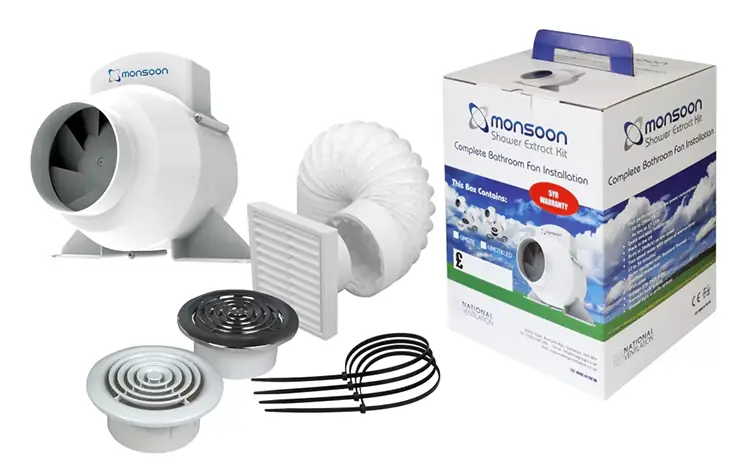
Conclusion.
Extractor fans are a must-have for your home. They keep your home smelling fresh and helps to keep the moisture levels down, decreasing the chance of mould developing. In this blog we have highlighted the different types of extractor fans and how to pick the right one for your needs. If you have any questions please don’t hesitate to contact us.

